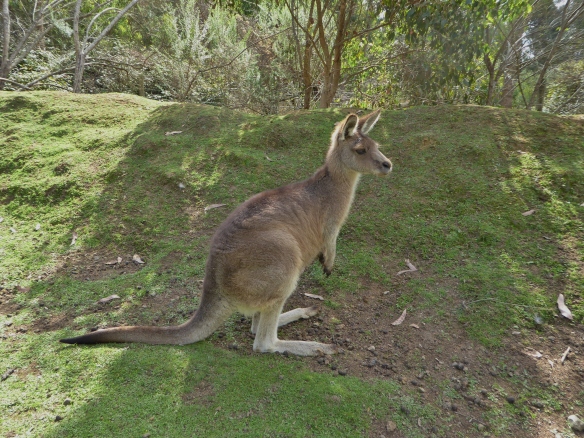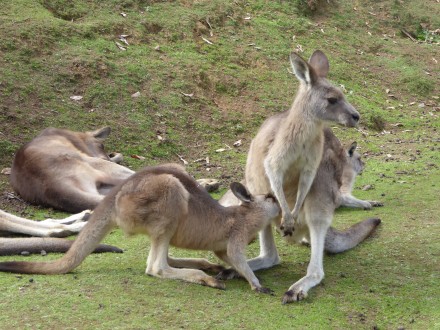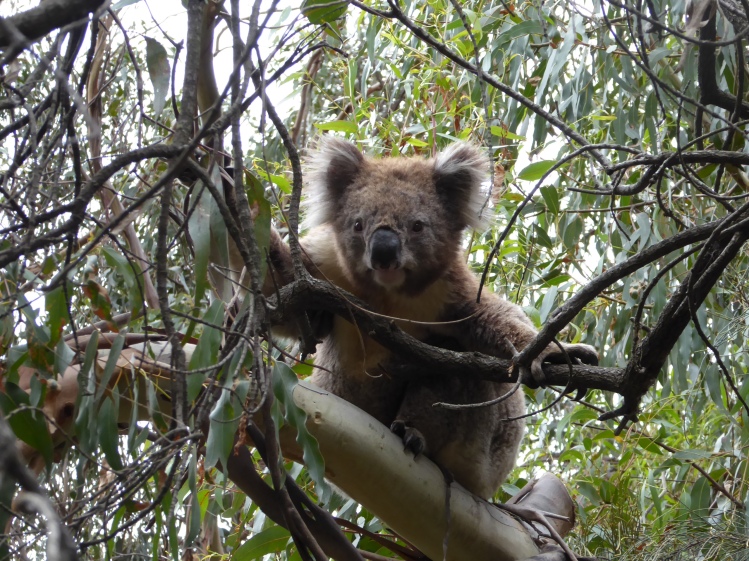
Wild Koala in Kennett River, Victoria, Australia.
Australia holds many distinctions from other countries: for starters, it’s the only island that is both a continent and a country, and, it has many of the strangest and most lethal animals on earth. Of its many weird fauna, none are as instantly recognizable as Australian as the kangaroo and koala, two of many marsupial species found only Down Under. In fact, Australia holds 70% of the world’s marsupials, with the remainder found in the Americas, predominantly South America. So, why are Australian marsupials so special and extraordinary? Probably their sheer uniqueness in looks and physiology, for starters. Definitely at least one, the koala, gets the Oooh and Ahhh Cuteness Award, hands down. But what I find interesting is the variety among these marsupial mammals.
Grey or “Forester” Kangaroo at the Tasmanian Devil Unzoo in Taranna, Tasmania.
Australian Icon: The Kangaroo
Take the most famous of Australian mammal, the kangaroo. The roos, as Aussies like to call them, are unusual because they are the largest marsupials in the world, and claim an additional distinction of being classified as macropods, a suborder of marsupials with dis-proportionally large hind legs and feet, and, dis-proportionally short forelimbs.
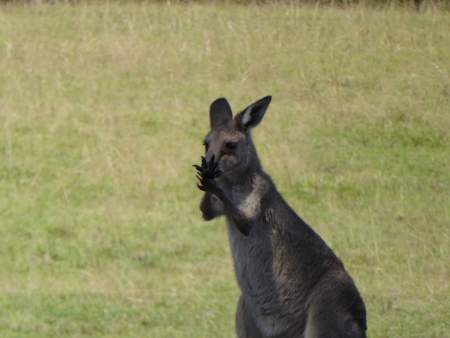
Note the delicate forepaws of this Grey Kangaroo. Tidbinbilla Nature Reserve, near Canberra in the ACT (Australian Capital Territory). There are several species of kangaroo, with another dozen or so macropod marsupials ranging downwards in size from wallabies to pademelons to bettongs, also called rat kangaroos. Regardless of their size, these macropods’ long, strong rear legs give them their only form of locomotion: hopping. Being a marsupial in the animal world means the female, a mammal, gives live birth to an incompletely formed fetus which continues to develop ex utero for several months within the female’s external pouch, feeding on the mother’s milk. Typically, the kangaroo offspring is called a “joey,” which also applies to the young of other pouched animals in the Australian marsupial order. With kangaroos the reproductive cycle gets even weirder as at any given time the mom could be nourishing three joeys in separate life stages: (1) an adolescent joey, out of the pouch, but still somewhat dependent on the mother’s milk; (2) a still-forming joey in the pouch, fully dependent on the female for life; (3) an unborn joey, just waiting to be “birthed” as soon as #2 moves out of the pouch. Or, as I like to think of it, the Kangaroo Halfway House.
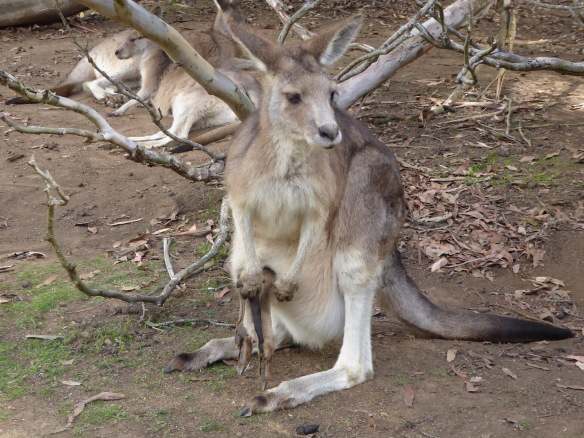
Joeys often hang upside down in their mother’s pouch. This particular one looks rather relaxed…I thought it might be dead, the way it was just hanging there, nursing or sleeping.
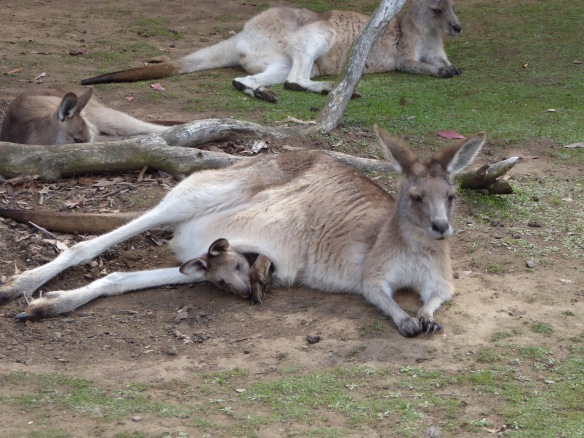
Eventually the joey emerged for a look-see. Apparently it didn’t like what it saw as it retracted back into Mom’s pouch. Both photos above taken at the Tasmanian Devil Unzoo, Taranna, Tasmania.
A Few More Facts….
The kangaroo is the largest marsupial alive today; among the varieties of roos, the Western Red is the largest, with males averaging 200 lbs. and 2 meters/6+ ft. in height. Eastern grey kangaroo/ Forester kangaroos can be as tall as the Reds, but have a smaller body mass. Males grow up to 6 ft.,& 145 lbs. (2+ m and 66 kg). They are quite fast and can reach speeds of 35 mph/56kmph. (This species is called “Eastern Grey” Kangaroo on mainland Australia and the “Forester” Kangaroo on the Australian island of Tasmania.
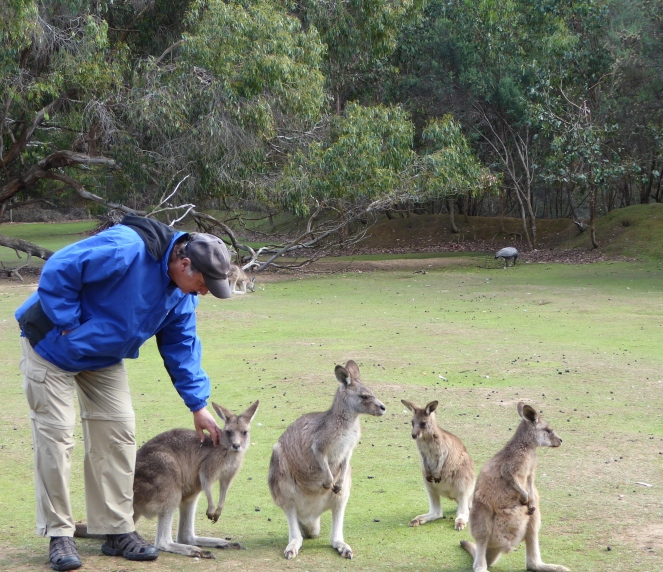
Above, Michael is making friends with a “mob” of young Forester kangaroos at the Unzoo, Taranna, Tasmania. The kangaroos in their several-acre compound at the Unzoo were very tame and obviously not bothered by close contact with humans.
Among macropods, males are larger than females. Tree kangaroos, such as Goodfellow’s below, are found in both eastern Australia and Papua New Guinea.
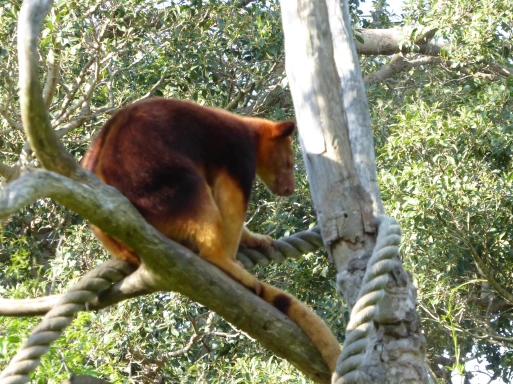
Goodfellow’s TreeKangaroo, Taronga Zoo, Sydney.
A group of wallabies or kangaroos is most often called a “mob,” but can also be referred to as a herd or troop. Both kangaroo and wallaby females can provide two nutritionally different types of milk to their joeys (off-spring), both to the one still developing in the mother’s pouch, and to another, older joey out of the pouch but still needing supplemental nursing.
Adolescent joey nursing. The Unzoo, Taranna, Tasmania.
Icon or Pest?
Now you’d think that Aussies hold the kangaroo in high esteem, since after all, the kangaroo is a national symbol — in fact, is the national animal — and is depicted on the Australian coat of arms.
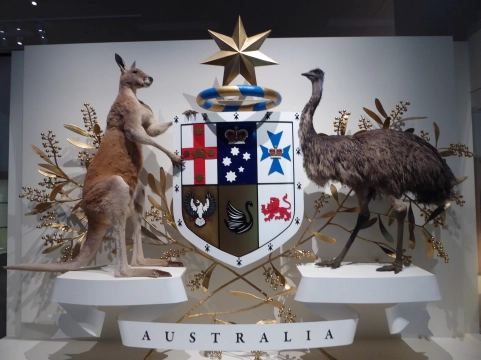
Neither the kangaroo nor the emu can walk backwards, and thus were chosen for the Australian coat of arms. Early “colonists” were British convicts, working off their sentences, followed later by voluntary immigrants, seeking a better life. For both groups, there was no “going backwards.” (Photo above is of a display at the Melbourne Museum.)
Nevertheless, many Australians consider roos pests as well as dangerous impediments to highway driving. (Which they are: an adult Eastern grey kangaroo has a larger body mass than a white-tail deer, and we’ve all had experiences with how much damage to car and person a deer collision can cause.) But there are other dangers posed by kangaroos.
Kangaroos are everywhere in Australia, including the desert, or outback, which comprises the bulk of the continent’s landmass. However, being herbivores, kangaroos tend to congregate where there’s plenty of vegetation, such as agricultural areas, and parks, lawns and gardens in more urban areas.
And…golf courses.
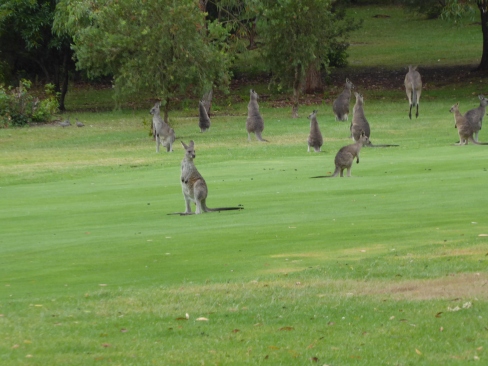
Golf course in Eden, New South Wales. The kangaroos are listening to loud wooden clappers wielded by golfers trying to scare the roos off the fairway.
One afternoon we spotted a large “mob” of a dozen plus kangaroos grazing on a fairway, surprisingly close to the highway. Pulling into the club parking lot, I skedaddled over to the edge of the fairway to get some photos. Somebody out of sight started banging clappers — loudly – and shouting at the kangaroos. At first the animals just raised on their haunches and stared at the source of the clapping, which I couldn’t see due to shrubs and trees shielding a bend in the course. As the clapping noise came closer, the kangaroos took off. The golfers appeared, the game went on.
Apparently, not all golf course-munching kangaroos are that skittish. The on-line edition of Golf Digest posted a video of two extremely rattled golfers in Australia taking off in their cart like bats out of hell, chased off the fairway by one royally pissed – and very fast — kangaroo. A Google search came up with several other entertaining videos of roos run amok. They really do “box,” using forearms and their huge hind legs to pound their opponents – it’s a bit like watching a male kangaroo version of Xtreme Martial Arts. Except XMA-ers don’t have lethally sharp hind claws that can eviscerate their rivals. No wonder those Aussie golfers were scared out of their minds.
All amusing roo stories aside, Australia, particularly along the eastern coast, has become inundated with kangaroos who are wreaking havoc in urban, agricultural and open-land areas. Mobs of kangaroos are “de-greening” huge swathes of parks and open land, as well as eating farmers’ crops – and causing vehicular accidents. As a result, for many years the national government has permitted the culling of up to 5 million kangaroos and wallabies per year, even though the kangaroo, the Australian national animal, is legally protected throughout the country. (Government estimates give the total number of kangaroos to be about 50 million. )
The government has specific regulations that the animals must be killed “humanely”, with a kill-shot to the brain or heart, and issues cull licenses only to specific individuals with proven marksmanship skills. The authorized hunts are conducted to eliminate kangaroos in an area where they have caused environmental destruction, or, hunts for “a commercial purpose…where the animal shot is to be used as a product to be sold within Australia or overseas.” (Source: the National Code of Practice for the Humane Shooting of Kangaroos and Wallabies for Commercial Purposes 2008.) “Product” is the hide and meat of the kangaroo; of the latter, 76% is exported to Russia. Who knew the Russkies had a hankering for Aussie roo?)
Australians are in continual debate about these cullings, both on ethical and legal bases. The issues are many and complex, not the least of which that Australia is the only country that authorizes the killing of its national animal, and that these “culls” supposedly constitute the largest kill-offs of any single species on earth (although I question if the kangaroo & wallaby “culls” are as massive as the white man’s wholesale slaughter of the American bison in the 1800s).
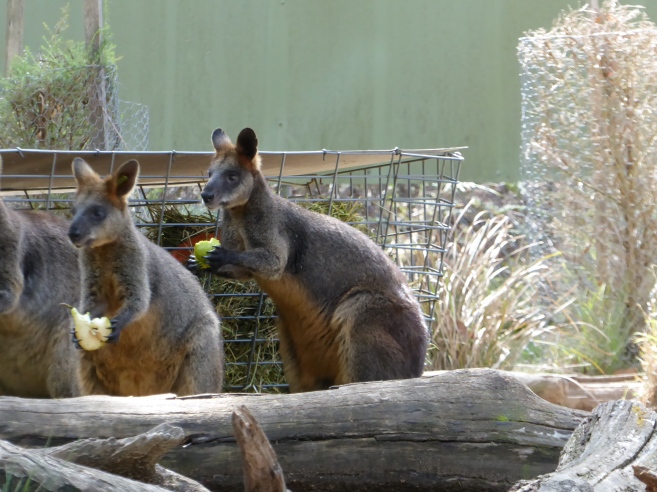
Rock wallabies at Tidbinbilla Nature Reserve, Australian Capital Territory. The wallbies’ brush diet is supplemented with hay and fruit by the Reserve staff.
Wallabies and Pademelons
Wallabies and pademelons are mid-sized to small macropods and closely related to the kangaroo. There are several species of both in inhabiting mainland Australia and Tasmania. Both are marsupial mammals and herbivores, but in general, wallabies are smaller than kangaroos, and pademelons are smaller than wallabies. There are other, morphological differences, and, generally, wallabies and pademelons prefer forested or brush and rocky areas where protection is more easily found. Their choice of habitat reflects their primary food source, leaves, along with some grasses, fruits and flowers, while kangaroos tend to eat mostly grasses. However, all these macropods – like their kangaroo cousins — like to plunder crops and gardens, earning themselves the enmity of farmers and gardeners throughout Australia. They are nearly equally good as kangaroos at causing thousands of road accidents each year. However, because of their smaller size, they tend to be on the wrong end of vehicular “intercepts” if the amount of roadkill is any indicator — especially among the small pademelons.
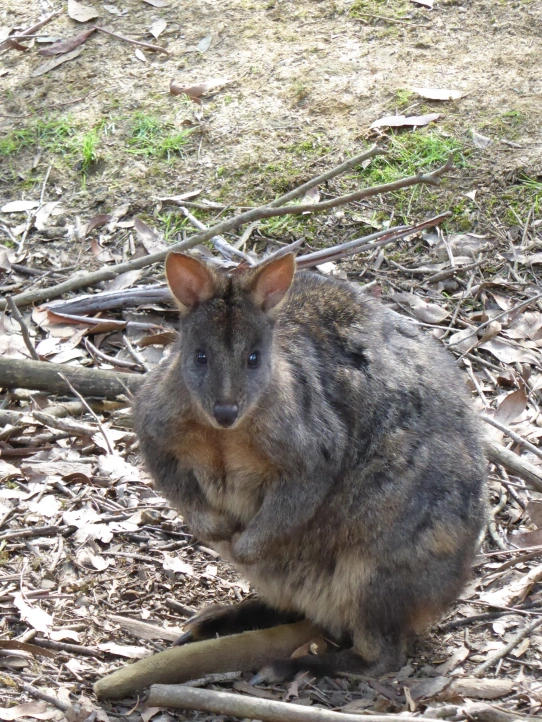
Pademelon at the Unzoo, Taranna, Tasmania. Normally very shy as a species, this pademelon, a larger male, allowed me to get within about 10 feet. Pademelons have extremely soft, fine fur and were once hunted for their pelts. The species we saw most frequently were Rock or Swamp wallabies and the Tasmanian pademelon. As with kangaroos, many Australians regard wallabies and pademelons as pests. As I snapped my dozens of photos we heard more than one Aussie deride tourists’ fascination with these critters. I’m sure a heap load of Americans say the same thing about tourists gawking at and photographing bison — except wallabies and pademelons are a heck of a lot cuter and smaller and can’t kill you if you mistakenly try to pet them. Unlike bison.
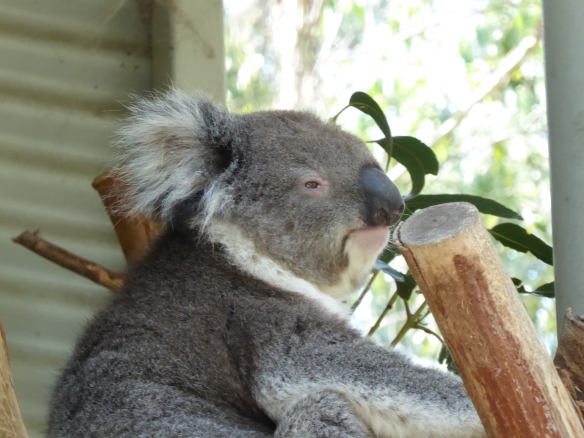
Grumpy Gramps just after awakening. This koala is one of several rescued during the massive brush fires of 2003 in which thousands of koalas and other animals died. About 70% of the total land area of the Australia Capital Territory was destroyed or damaged during the fires. Those rescued animals which could be rehabilitated were returned to the wild; this koala and several others could not be released and are comfortably living in an artificial habitat at the Bibindilla Nature Reserve.
Just “Koala,” Please!
Almost iconic as the kangaroo, the koala holds a special mushy place in hearts worldwide. Once called koala “bears,” the Politically Correct Zoological Police have been able to educate most of us to now chant, “They’re koalas, they’re marsupials, not bears.” Nevertheless, these fat, stubby, near-sighted and fuzzy-eared marsupes have continued to captivate peoples’ hearts and sappy adoration on a level rivaling the panda. However, this state of admiration hasn’t been the norm historically: through much of the 19th and well into the 20th c. koalas were hunted for their thick, soft fur. Souvenir shops commonly sold koala “toy animals” covered in real koala fur.
Nowadays the koala’s major threats are still human-related, but not through hunting: their greatest threat is from habitat destruction (primarily from land clearing, brush fires, and food source loss due to eucalyptus dieback), as well as vehicular traffic, and attacks by domestic dogs, feral cats, and foxes. Chlamydia is an endemic bacteria naturally occurring among the koalas, although not as a sexual disease. (No, koalas aren’t any more promiscuous than any other mammal.) The presence of chlamydia normally doesn’t kill off healthy koalas, but can weaken their systems in times of major stress, rendering the animals unable to recover. While not endangered or threatened as a whole, the Australian government has listed koalas only in certain mainland eastern zones as “threatened,” but has not as yet enacted legislation to actively protect koalas or limit habitat destruction. The mostly nocturnal, tree-dwelling koala sleeps about 18-20 hours during the day, and when not sleeping, scoots languidly along the branches of eucalyptus trees munching on the tender leaves of its choice. They are fairly social animals among themselves and several will live harmoniously together within the same home range, but can be territorially protective against invading koalas.
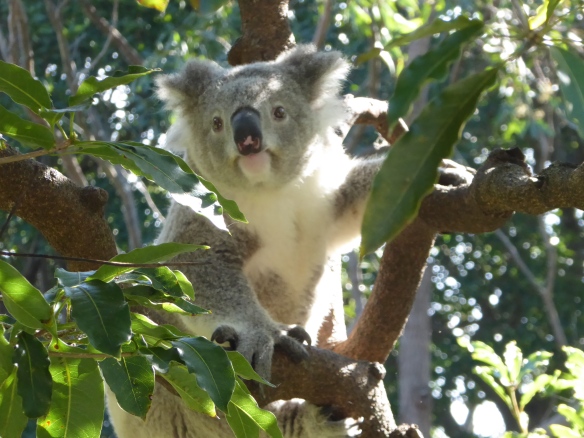
Koala at Taronga Zoo, Sydney. Note the thick digits and claws; these enable the koalas to climb about eucalyptus trees, their sole food source. These exceptionally strong and long claws can also be the koala’s only defense against predators (other than helping them to climb out of range).
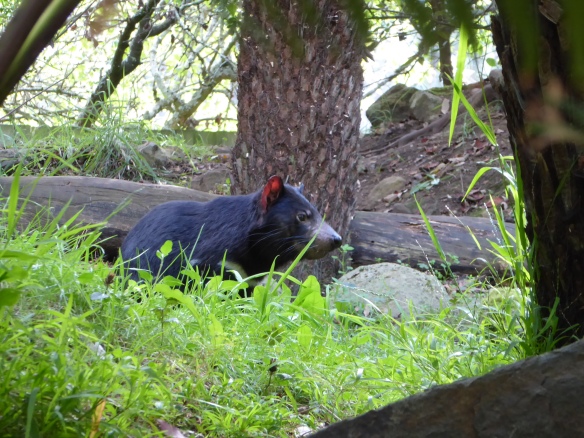
A young devil at the Tasmanian Devil Unzoo, Taranna, Tasmania.
Bedeviled in Tasmania
Tasmanian devils break the mold of the grazing, group-gregarious, gentle marsupial. Devils are strictly carnivorous, and nastily so; they are solitary, coming together primarily for mating, which itself is surprisingly brutal. Over-sized heads with bone-crushing jaws and razor teeth, devils unsurprisingly have a hellish reputation for an animal that averages 20 pounds. All in all, devils are one of the most aggressive and hard-living of marsupials – nothing like that lovable, Loony Tunes whirlwind Taz.
The gaping jaws are probably the only similarity to the Looney Tune version of Taz.
Once found throughout Australia, devils are now native only to the island of Tasmania. Through the last 200 years devils have survived aggressive hunting from bounties placed on their heads by settlers seeking to protect their livestock (although devils rarely went after anything larger than chickens). Numbers steadily increased once the government extended total protection in 1941, but the Tasmanian devil is once again facing possible extinction, this time from a species-specific, virulently infectious, fatal cancer called the Devil Facial Tumor Disease (DFTD) which first appeared in the mid-90s. Government experts have estimated that as much as three-fourths of wild devils have died due to DFTD. The Tasmanian devils are classified as endangered by the Australian government and world conservation organizations.
In the absence of any cure or vaccine, the Tasmanian Parks Service and conservationists are establishing protected DFTD-free zones and preserves, hoping to keep a small percentage of the wild devils healthy and breeding while allowing the diseased population to die off. Sounds cruel or defeatist, but with no cure or vaccine in sight, saving some of the species is currently the only recourse available, especially as the disease is rampant among the wild population. Fortunately, the devils in the few protected preserves seem to be breeding in sufficient numbers that could help provide and sustain a disease-free devil population for the future.
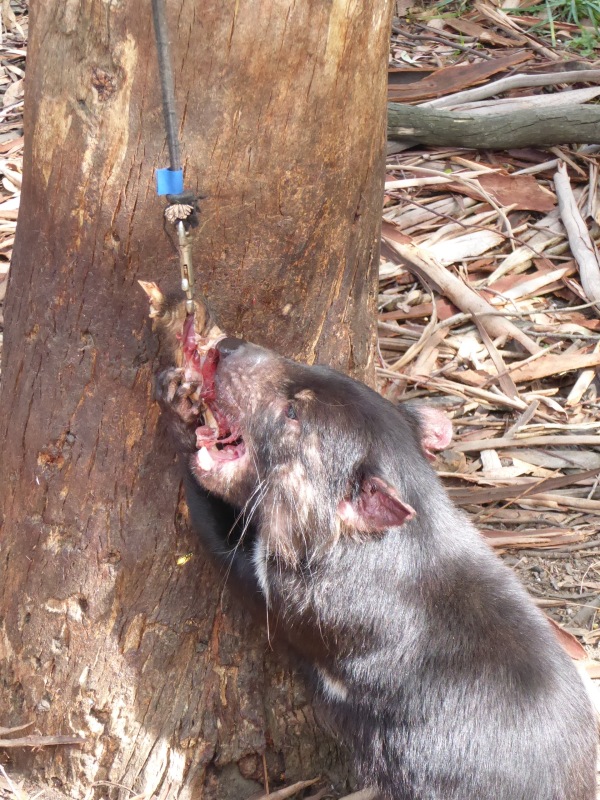
“Neville the Devil” at 6 years is a Senior Citizen. Nevertheless, he attacks his meal (a wallaby haunch) with great gusto and fierce growls.
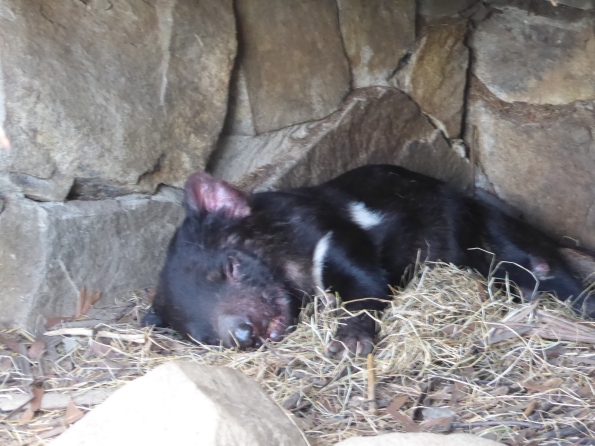
Neville in repose. Tasmanian devils are mostly nocturnal and Neville as an aging devil likes his naps.
Some Devilish Facts:
- When devils eat, they consume everything, including the bones of their prey.
- Despite their aggressive, fearsome natures, devils are predominantly scavengers, not hunters.
- Devils are primarily solitary and nocturnal.
- Devils aren’t large, the size of a small but sturdy dog, with large males weighing up to 12 kg (26 lbs.).
- The black coloration, bone-chilling screech and massive, toothy gape of the devil helps this critter live up to its name. Listen to a devil vocalization here.
- The average devil lives to about 5-7 years.
- Once hunted and reviled, the Tasmanian devil is now the symbol of the Tasmanian National Parks and Wildlife Service.
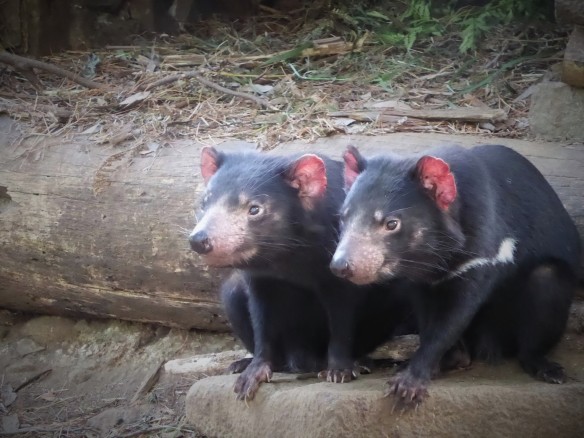
These two young devils were bred at the Unzoo. Hopefully, captive breeding programs will continue to produce healthy devils which can be released to the wild in the future to protected, DFTD-free zones to establish new, healthy populations.
Eastern Quolls
I’d never heard of the Eastern quoll, another of Australia’s carnivorous marsupials. About the size of a small cat, the Eastern quoll commonly is found these days only in Tasmania, which has a stable population of these little critters. Of the six extant species of quoll found in greater Australia, only the Eastern quoll has gone extinct on mainland Australia, although there have been claims of isolated sightings in the southeastern region in recent years.
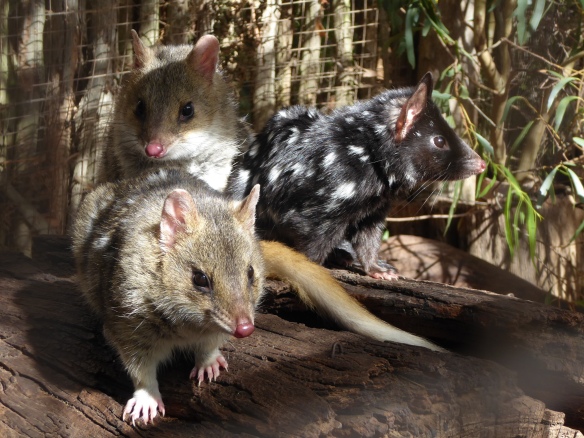
Three young Eastern quolls. The fawn-colored duo are males; their coloring is typical of most quolls. The black and white is a female, and was much shyer than her male counterpart. The black and white coloring appears in about 30% of the quolls.
More Facts:
- The quolls are carnivorous, eating insects, reptiles and small mammals, especially rodents; they will both hunt and scavenge.
- In the wild they are fairly solitary, congregating primarily for mating.
- They are crepuscular/nocturnal in the wild.
- Certain predators such as foxes, dogs and cats prey on the Eastern quoll as well as compete with them for food.
- The greatest threat to quolls is habitat destruction from human activities: urbanization, agricultural expansion, and mining. Forest and brush fires also have destroyed much habitat.
- The quoll is often referred to as the “native cat.” In fact, many settlers kept quolls as pets, as these little carnivores often kept the farmstead free of mice and rats.
And last but definitely not least….

The wombat. Definitely a very unusual animal.
The Wombat
Confession time: I never saw a live wombat once during our 6 weeks in Australia. Stuffed wombats in dead-wildlife displays, dead wombats on the road verge – saw lots of those. Not one in the flesh, alive. But, wombats are among the oddest of Australia’s marsupials, which is why I saved them for last.
These large, pudgy, furry marsupials are herbivores, feeding on grasses, roots, moss and even bark. They look like small, barrel-like bears, and have strong legs and long claws for digging burrows. As always, some basic facts: (But wait! There’s more!)
Wombats are the closest relative to the koala.
Generally they are solitary, but live in extensive burrow systems. These multi-chambered burrows may be occupied by a number of wombats, but with one wombat per den within the burrow. Wombats only produce one offspring every 2 years. They are primarily nocturnal but also crepuscular as well.
The wombat can reach a meter or 40 in. in length, with an average weight between 20 and 35 kg (44 to 77 lbs.). Wombats are deceptively fast, running at speeds of up to 40 km or 25 miles per hour. Unfortunately, they aren’t fast enough; they have a high fatality rate along highways, despite the frequent Wombat Warning signs.
Wombats suffer from sarcoptic mange, caused by a parasite. Once infected, the animal eventually becomes blind and deaf, and often dies from bacterial infections, if not starvation. Die-off in Eastern Australia has been massive. The penultimate fun fact about wombats is that Wombats have very strong, tough butts. If attacked by another animal, the wombat jumps into its burrow, using its butt to block the burrow entrance. If the attacking animal persists (foolishly) in attempting to unwedge or bite-and-pull out the wombat by worming its head into the burrow, the wombat uses its powerful hind legs to suddenly push its massive butt up, crushing the attacker’s skull. (Now that’s impressive. The “killer-butt maneuver.”) Wombats must have a thing about butts, because that’s what they aim for when they attack another animal. But the most interesting feature of wombats is their “fecal waste,” those cubed pellets of poop.

Wombat poop. Tootsie Rolls, anyone? Yup. Wombats poop out cubes. A lot of them. As do many animals, wombats use their scat to to “mark” their territory, strewing up to 100 of these squared off Tootsie Roll-like cubes around their turf. Nothing new or different with their intentions to poop and mark – but in cubes?
So, hats off to the lowly, weird wombat, probably one of the weirdest marsupials in Australia. Who’d’ve thunk it?
![]()

Carol Barbier Rolnick grew up in Japan and Southeast Asia, traveling extensively as a child through Asia, the Mideast and Europe on family vacations. Travel has continued as a priority through raising kids and continuing into retirement, extending adventures through the Americas, southern Africa, Asia, and repeat trips throughout Europe. Carol and her husband, Michael spent four summers based in Utrecht, The Netherlands, which has become like a second home. They are (still) aiming towards Australia-New Zealand and Antarctica to round off their continental travels.

